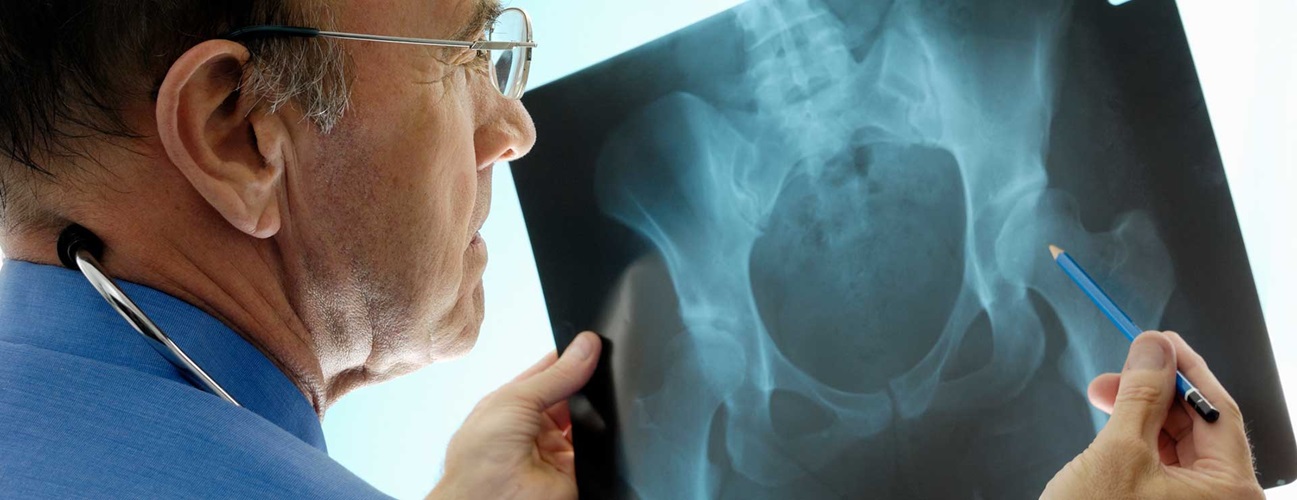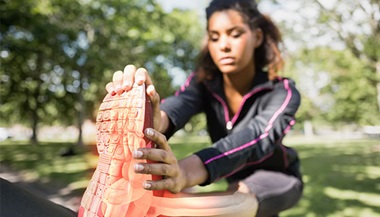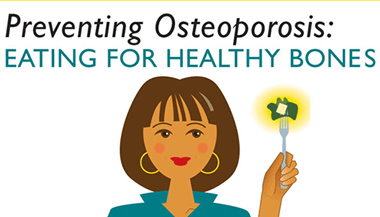Osteoporosis: What You Need to Know as You Age
Overview
Osteoporosis, literally “porous bone,” is a disease that thins the framework inside bones so much that even a minor fall or bump against a car door or piece of furniture may cause a fracture. A break can happen at any spot on your skeleton, but fractures of the wrist, hip and spine are among the most common.
Keeping your bones strong is a smart goal at any age. But a fracture-proof frame becomes a bigger priority in the decades after age 50, when weakened bones lead to breaks for one in two women and one in five men. Fortunately, there are plenty of steps you can take at home and with your doctor’s help to protect against painful fractures that can reduce your independence and, surprisingly, even increase your risk of dying due to medical complications.
Causes and Risk Factors
Normally, we can’t feel what’s happening inside our bones, explains Deborah Sellmeyer, M.D., medical director of Johns Hopkins Metabolic Bone Center. Yet throughout our life, a team of specialized cells is constantly updating the microscopic framework of collagen (a type of protein) and minerals, including calcium, that keeps bones strong. Like a never-ending highway reconstruction project, old bone is broken down and replaced daily with new bone.
Until about age 25, this project adds more new bone than it takes away, so bone density increases. From about age 25 to age 50, bone density tends to stay stable with equal amounts of bone formation and bone breakdown. After age 50, bone breakdown (resorption) outpaces bone formation and bone loss often accelerates, particularly at the time of menopause.
The risk for osteoporosis and osteopenia—low bone density that’s not yet in the osteoporosis range—is higher in women because female bones typically are smaller and less dense than male bones. The risk increases at menopause, when levels of bone-bolstering estrogen fall. But men are also at risk. A family history of osteoporosis-related fractures boosts odds for both sexes.
Certain medical conditions can threaten bone strength directly or via the effects of medicines and other treatments. These include overactive thyroid or parathyroid glands, chronic lung disease, cancer, endometriosis, a vitamin D deficiency and medications such as prednisone.
Other risk factors include these conditions and practices:
- low intakes of calcium, vitamin D, potassium or protein
- inactivity
- cigarette smoking
- overuse of alcohol
- long-term use of such medications as glucocorticoids (such as prednisone for asthma or arthritis), some antiseizure drugs and overuse of aluminum-containing antacids
- eating disorders that reduce your body weight
- low levels of estrogen (for women) or testosterone (for men)
Prevention
It’s never too early to start thinking about maintaining bone mineral density. These steps can help prevent osteoporosis.
Hit your calcium quota. “There is no doubt that getting enough calcium reduces fracture risk,” Sellmeyer notes. “There has been controversy recently about possible links between calcium supplements and vascular calcification [calcium depositing in blood vessels], but this was seen in one study and has not been seen in many other studies of calcium and vitamin D.” Everyone should meet but not exceed the recommended intakes listed below. Food sources of calcium have other good nutrients for bone, such as protein and magnesium, and can provide all your calcium needs. For those who have difficulty meeting their calcium requirement through food, supplements are a good alternative.
Aim for these calcium levels:
- 1,000 milligrams daily for women age 50 and younger and for men 70 and younger
- 1,200 milligrams daily for women over age 50 and men over 70
“The one exception: People on dialysis due to kidney failure should talk with their doctor about the right calcium intake for them,” says Sellmeyer.
Take in calcium from food or supplements. Calcium-rich foods include:
- low-fat or fat-free milk or yogurt (300 mg per cup)
- greens, such as kale (100 mg in 1 cup cooked kale)
- tofu that uses calcium for firmness (253 mg per half cup)
- beans (81 mg in a half cup of white beans, about 40 mg in a half cup of pinto beans, 23 mg in a half cup of black beans)
- calcium-fortified foods, like breakfast cereals and orange juice (up to 1,000 mg per serving)
Calcium on food labels is given as a percentage of 1,000 mg, so if the label says “45 percent,” a serving of that food provides 450 mg of calcium.
Add vitamin D. Getting enough vitamin D helps with calcium absorption and incorporation into your bones. “The current recommendation is 600 IU of vitamin D per day through age 70 and 800 IU per day after age 70,” Sellmeyer says. “Some individuals may need more to achieve good blood vitamin D levels. It’s difficult getting all of that from food every day, so you may need a vitamin D supplement to reach these goals.”
Fit in potassium and protein. In 2013, research by Sellmeyer and colleagues at Johns Hopkins found that potassium improved calcium metabolism. Adults need 4,700 mg per day, but most fall short. You’ll find this mineral in fruits and vegetables, especially bananas, potatoes (with the skin), prunes, orange juice, tomato juice, raisins, acorn squash, lima beans and spinach. Get enough protein too. “Bone is interlocked protein strands with minerals and calcium attached, so protein is important for strong bones,” Sellmeyer says. “In some studies, protein has helped with bone healing too.”
Get weight-bearing exercise regularly. Walking, dancing, aerobics class, weight training: “Any activity that puts your bones to work stimulates the remodeling that keeps bone strong,” Sellmeyer says. “You don’t have to pay for a gym membership; just get outside and walk. Start with 15 to 20 minutes a day. If you’re frail, start by working with a physical therapist who can help you move properly to get results and stay injury-free.”
Cut back on caffeine and alcohol. Drinking either in excess can reduce your bone density.
Quit smoking. Tobacco use leads to significant bone loss in women and men, longer healing times after a fracture and a higher risk for complications. Quitting can reduce the added risk.
A Woman's Journey Presents: Bone Up - Osteoporosis
Diagnosis
“Osteoporosis—the loss of bone density and weakening of your skeleton—is a silent disease and causes no symptoms until someone has a fracture,” says Sellmeyer. So one of the most important steps you can take is to schedule a bone scan when recommended. Bone density tests are recommended for all women age 65 and older, and for younger women at higher-than-normal risk for a fracture. Men may want to discuss osteoporosis screening with their doctor if they’re over age 70 or at high risk for thinning bones. Talk with your doctor about an earlier scan if you have any warning signs or risk factors for osteoporosis:
- a bone fracture after age 50
- sudden back pain
- loss of height or increasingly stooped posture
- use of medications that can thin bones
- a bone-threatening medical condition, such as those listed above
- a family history of osteoporosis or fracture
A bone densitometry test (DXA or DEXA scan) measures your bone mineral density (BMD). Your bone density is then compared to the average BMD of an adult of your sex and race at the age of peak bone mass (approximately age 25 to 30). The result is your T score.
- A T score of -1 to +1 is considered normal bone density.
- A T score of -1 to -2.5 indicates osteopenia (low bone density).
- A T score of -2.5 or lower is bone density low enough to be categorized as osteoporosis.
It’s important to know that every one-point drop below 0 (0 is BMD on par with a 25- to 35-year-old) doubles the risk for a fracture. Your doctor may also use your BMD results to help calculate an estimation of your risk for any fracture and for a hip fracture in the next 10 years. This fracture prediction is based on your bone density and other risk factors for fracture, such as family history and smoking.
Treatment
If you have osteopenia or osteoporosis, your doctor will recommend prevention steps (outlined above) to help slow down additional bone loss and reduce fracture risk. In addition, she may recommend an osteoporosis medication.
The medication choice will depend on the extent of bone loss, your tolerance for various medications, and the goals you and your doctor set together. “Discuss the risks and benefits of taking a medication—and of not taking a medication—with your doctor,” Sellmeyer suggests. “The side effects of some osteoporosis drugs have received a lot of attention in the media, but deciding not to take one could mean you’re missing out on significant protection against a fracture. Not taking a medication also carries risks. There are trade-offs to think about.”
There are five major types of osteoporosis medications:
- Calcitonin is a once-a-day nose spray that studies have shown reduces spinal fractures by 25 percent. “There’s no evidence that it lowers risk for other fractures,” Sellmeyer says. “But it is one of the best-tolerated osteoporosis medications.” There has been some recent concern about a possible 1 percent increased cancer risk with this medication, and it was reviewed by the FDA, which has kept it on the market while recommending the risks and benefits be discussed by each patient and her physician.
- Raloxifene is a once-a-day pill; studies have shown it reduces spine fractures by 30 percent. “Raloxifene works by blocking estrogen’s action in some tissues and stimulating it in others,” Sellmeyer says. “It can also reduce breast cancer risk but can cause hot flashes and raise risk for blood clots.”
- Bisphosphonates can reduce the risk for spinal fractures by 50 percent to 60 percent and hip fractures by 50 percent. These drugs are available as a once-a-day or once-a-month pill or as a once-a-year intravenous infusion. Side effects include upper gastrointestinal symptoms like heartburn with the oral medications and flu-like symptoms after the first infusion of the intravenous medications. There are also rare risks like poor healing after dental work (approximately 1 in 50,000 patients) and stress fractures after long-term use (approximately 1 in 75,000 patients). Most doctors use these medications intermittently: five to eight years of treatment followed by one or more years off medication, then another five to eight years of treatment if fracture risk is felt to warrant additional medication.
- Denosumab is given as an under-the-skin injection twice a year and can reduce the risk for spine fractures by 50 percent to 60 percent and hip fractures by 50 percent. This medication was FDA-approved in 2010. Side effects include skin reactions like rashes or eczema and a small increased risk of infection.
- Parathyroid hormone is given as a once-a-day, under-the-skin injection and can reduce spine fracture risk by 65 percent and the risk for other fractures by 53 percent. “This medication stimulates bone remodeling rather than just slowing down bone breakdown, but use is limited to two years at this point,” says Sellmeyer. Side effects include skin reactions at the site of the injection, increases in blood and urine calcium, and bone pain. In high doses, this medication causes a bone cancer called osteosarcoma in rats, but this has not been seen in people.
Learn more about the symptoms, diagnosis and treatment of osteoporosis.
Living With
A diagnosis of osteoporosis can change your life, but you can manage your condition with the healthy steps outlined in the “Prevention” section. Here are a few more tips to help you stay safe and enjoy, as much as possible, the activities you’ve always loved.
Stay active and connected. A physical therapist can help you find ways to move safely in activities and even enjoy a physical relationship with your partner. If you need to modify sport or hobby participation, explain your situation to loved ones and brainstorm new ways to spend time together.
Maintain your balance. Prevent falls by keeping your eyeglass prescription up-to-date and by getting help for hearing loss. (Diminished hearing increases the risk for falls and balance problems.) Keep floors and stairs clear of obstacles that could trip you. Ask about a referral to a physical therapist for safe muscle-building exercises or advice from your doctor about exercises that are right for you. Strong muscles lower your risk for a fall. Ask about exercises that can help you maintain healthy posture, which may reduce the risk for a spine fracture. If your doctor has recommended that you use a walker or cane after an osteoporotic fracture, do so—it will help your balance and allow you to stay more active. If you feel drowsy or dizzy, ask your doctor if this could be a side effect of other medications you may be taking, and ask what you can do about it.
Talk through feelings. Bone loss may lead to feelings of depression if you feel you can no longer do the things you enjoy or have lost independence. Talk with your doctor about your mood and any anxieties you have. Look into support groups too. You’ll find listings on the website of the National Osteoporosis Foundation, nof.org .
Research
Johns Hopkins experts are looking at osteoporosis in many ways but with one aim: preventing this condition and improving life for people who have it. Here are some notable findings:
Strong muscles reduce the risk for fragile bones. In a Johns Hopkins study of 84 people, researchers found that those with more muscle strength were less likely to have low bone mineral density. That may be because activities that build strong muscles also stress bones, thus stimulating growth.
Bone checks reduce hip fracture risk. In a study of 3,107 people, Johns Hopkins scientists found that those who were screened for osteoporosis were 36 percent less likely to have a hip fracture in the next six years. The reason: Screenings can uncover thinning bones in time for treatment, the researchers suspect.
For Caregivers
You can help a loved one stay strong and fracture-free with these strategies.
Serve a strong diet. When you cook, prepare meals, snacks and desserts that contain bone-friendly foods and ingredients.
Make the most of meds. Help your loved one remember to take osteoporosis medications as directed.
Try simple but powerful fall prevention. Encourage your loved one to wear glasses and hearing aid if needed and to reduce fall risk by wearing supportive shoes and keeping floors clutter-free.
Cheer on fitness. Support your loved one’s efforts to stick with exercise routines recommended by the doctor or physical therapist.
Keep spirits high. If your loved one’s activities are more limited now due to osteoporosis, help her find new ways to socialize and enjoy life.






